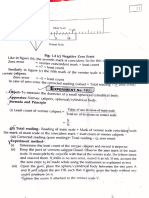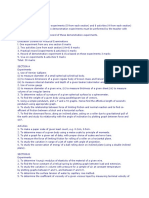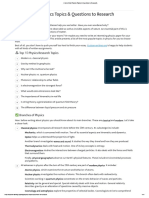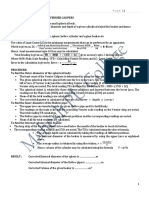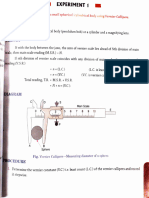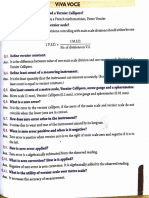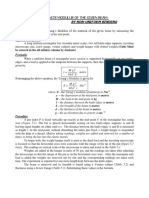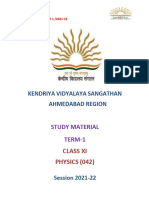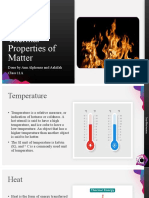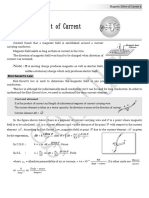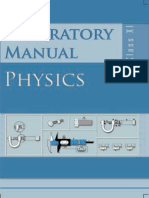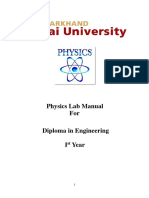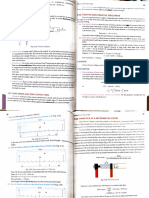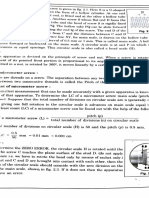0 ratings0% found this document useful (0 votes)
346 views34 pagesPhysics Practical
Class 11 physics practice
Uploaded by
ar2804pitaCopyright
© © All Rights Reserved
We take content rights seriously. If you suspect this is your content, claim it here.
Available Formats
Download as PDF or read online on Scribd
0 ratings0% found this document useful (0 votes)
346 views34 pagesPhysics Practical
Class 11 physics practice
Uploaded by
ar2804pitaCopyright
© © All Rights Reserved
We take content rights seriously. If you suspect this is your content, claim it here.
Available Formats
Download as PDF or read online on Scribd
You are on page 1/ 34
To measure the diameter of a small spherical/eylindrical body using veEnien!
UAE callipers,
APPARATUS
Vernier callipers, the given sphere or cylinder.
THEORY
Vernier Callipers : It is an instrument designed by a French mathematician, Pierre Vernier for accurate mea-
surement of length
A geometry box scale can measure length accurately only upto one mm whereas a vernier callipers can moa-
sure length accurately upto 1/10th of a mm or even less depending on its design
Movable jaws
(’.
a
0 3 Seg Dens
Gy) ladon yun tl
eee tt iat ons
Vom sale
Fes
foe 8
Fig.)
A vernier callipers consists of a steel strip $ graduated in centimettes on one edge. This scale, also called the
main scale is fixed. Another small scale, called vernier scale can slide aver! the main scale. By means of a screw Sy
the vernier scale can be fixed on the main scale in any position. The V.S. divisions are slightly smaller than the M.S.
divisions. The instr
ment is also provided with two sets of jaws ; the fixed jaws A and C and the movable jaws B
and Dall normal to the main scale, To measure the external diameter ; the object is held between the jaws A and B
whereas the internal diameter is measured using the jaws Cand D. There is a thin steel strip E attached to the back
side of S,. The strip moves with the vernier scale and is used to find the depth of a container.
Least Count : It is the minimum measurement which an instrument can accurately measure For a vemier
callipers, the least count is also known as vemnier constant (VC)
Determination of Vernier Constant or Least Count : Note the value of the main scale division and count
the number “n’ of vernier scale divisions (VSD). Slide the moveable jaw till the zero of the vernier scale coincides
with any mark on the main scale, Count the number of divisions on the main scale coinciding with the n divisions
of the VS.
We have nVSD = (n-1)MsD
1VSD =
Vernier constant =
In general n = 10 and 1 MSD = 1 mm, Therefore, VC = 3 x 1mm =001em
Zero error and Zero correction : Slide the vernior scale so that the jaws A and B touch each other. Three
possibilities arise
(@) The zero of the VS coincides with the zero of the main scale, zero error is nil.
9 1 us)
vs
wo
(i) The zeto of the VS lies to the right of the zero of the main scale. The instrument in said to have positive
zero error.
ne.
0 5, '10
Cc)
Record the order of vernier scale division coinciding with any of the main scale divisions (say 3° as
shown above)
Zoro error = +3 VC
= + 0.03 cm
Zero correction = ~ 0,03 em
‘The actual length is 0.03 cm less than the measured length.
B Practical Physics—Class XI
(iti) Zero of the vernier scale lies to the left of zero of the main seale. In this case, the zero error is negative
Record the order of vernier scale division coinciding with any of the main sctle divisions (say 7" as
shown above)
Zero error
-3x VC =-0.03 em @=10-7)
+.0.03 em.
The actual length is 0.03 em more than the measured length.
Zero correction*
NOTE: Zero error is always subtracted. In other words zero correction is always added with its sign.
DIAGRAM
See ther
PROCEDURE
1, Count the number of divisions #i on the vernier scale, Find the value of each MS division. Make the zero
of the VS coincide with any division of the MS. Count the number (ri ~ 1) of the MS divisions coinciding
with the » division of the vemier scale. Calculate the vernier constant. (VC = 1. sp).
Make the jaws of the vernier callipers touch.each other. Record the zero error in the yernier callipers as
explained above. Calcutate zero correction to be applied with proper sign.
Open the jaws of the vernier callipers and hold the given sphere or cylinder between the jaws without
applying any undue pressure.
4. Record the MS reading just before the zero of the VS. Let it be « cm.
5. Find the number (order) of the VS division coinciding with any of the divisions on the MS; let it be x
6. Repeat the above steps 3 to 5 at least five times to get different observations for the diameter,
OBSERVATIONS
va
Value of the one MS division
10 VS divisions = 9 MS divisions
1S division = JF MS division
Vo = 1MsD-1 sD
2 ae
= 1Msp-2 Msp
1 Bos
1 msD=: =0.01em
= pMSD=sbx0.10m=0.01
Fo be added with proper ign
Practical Physics—Class XI
em
Zero error in the vernier callipers = +
Zero correction =
DIAMETER OF THE CYLINDER
cm
3.0 8 (8x 0.01) cm 3.08.cm
‘Mean observed diameter D
cm
Corrected diameter
Observed diameter + (zero correction)
cm
“RESULT
Diameter of the given cylinder = cm
GB
PRECAUTIONS
1, The jaws should not be pressed too hard against the sphere/cylinder.
The
ero error should be noted carefully and the necessary correction should be applied.
‘The diameter to be measured should be parallel to the scale.
‘The observations should be recorded from different positions.
The error due to parallax should be avoided.
2
The reading of the vernier scale should be recorded carefully.
EXPERIMENT AUOy
A To measure the dimensions of a given rectangular block of known mass
eCIEM vornier calipers and hence find its density.
APPARATUS
Vernier calipers, the given block, spring balance.
*TYPICAL EXAMPLE: See Fig, (°) which has no zero error,
Ea Practical Physics—Class XT
Q5. What is the advantage of using vernier | Q.10. What is the maximum probable error in
callipers over conventional scale for the diameter recorded by a vernier
‘measurement of length ? callipers ?
‘Ans. The vemier callipers gives accurate read Ans. 0,01 cm ie. its least count.
diye to its smaller least count, Qt. When is zero error in the calipers
positive?
Q6. Why do we record an observation for a
putabenok umes? ‘Ans. Zero error is positive if on making the jaws
touch each other, the zero of the vernier
Ans. Tominimise error. scale lies to the right of the zero of the main ;
Q.7. What causes zero error in the vernier scale.
calipers ? Q.12, When is zero error in the callipers
‘Ans, The zero error in the callipers is either due negative ?
to manufacturing defect or due to wear and Ans. Try yourself.
tear caused by long use 0.13. What is the relation between zero
correction and zero error?
Q.8. How many metre make one mm ?
Ans. Zero correction = - (Zero error),
| Q:18 Give relation between (i) litre and cc (ii)
Ans. 10°,
Q.9. Whatisthe difference between 1.2em and
aes et | mand cc.
20 cm? Explain,
te Ans. 1 litre = 1000.ce
‘Ans. 1.20¢m is more accuratemeasurement as it Lm?=i0cc i
aac greater number of significant as Wiki is'St unit dt density?
i
‘Ans. kgm)
ie eee
SCREW GAUGE / MICROMETER
HExPERiMenT/ A107
cs to find the diameter of a wire with the help of a serew gauge and hence find its”
volume. i
APPARATUS
Sctew gauge, wire, metre scale
Screw gauge :
It is an instrument used to measure length with an accuracy of 0.001 em or less.
tt works on the principle that for an evenly threacied screw, the linear distance covered is directly proportional
to the rotation given to the screw.
=
The main parts ofthe screw gauge are as shown in the diagram. [Fig (0)
Practical Physics—Class XI
Linear
ined Bevalled surface
screw #9! cies (easy oft cap graduated
j howapate
ees
fet Cap \
ifornce Screw neaa
wa ete
stl frame
Fig. (@)
() Linear scale (graduated in mm).
(ii) Circular scale (divided into 100 equal parts).
(iii) U-shaped metallic frame.
(iv) A fixed stud ‘A’
(2) A moveable stud ‘3
(vi) Ratchet arrangement to avoid any undue stress on the abject whose dimensions are to be measured.
THEORY
Pitch of the screw + I
rotation. It is equal to the distance b
is defined as the linear distance moved by the serew when it is given one complete
‘een consecutive threads of the screw as mei
sured along the axis of the screw.
Least Count : It is the minimum distance which can be accurately measured by the screw gauge.
Itis measured as the ratio of the pitch to the number of divisions on the circular scale.
itch
Least count = —
number of divisions on the circular seale
micrometer with pitch 1 mm having 100 divisions on the circular scale
1mm _ 0.01 mm
100
Least count
0.001 em = 10°? m =10 um
Note : The screw gauge is also called micrometer because its leust count is ofthe oriter of 10 jun.
Determination of pitch of the screw and the least count : Make the zero of the circular scale coincide with the
zero of linear scale. Give five complete rotations to the screw. Record the final reading on the linear scale coincid-
ing with the zero of the circular scal
distance travelled on the main s¢
Then, Pitch =
number of complete rotations
5mm
Practical Physics—Class XT E
Record the number of divisions on the circular scale,
teh
Least count =
Soun\ = ‘otal number of divisions on Gieular scale
= fimmy _
= (Be) 0.01 mm,
= 0.001 cm
Zero error: When the jaws of the screw gauge touch each other ; the zero of the circular scale should coincide
sith the reference line on the main scale. Ifitdoes not, the screw gauge is said to have zero error. The zero error
ce following two types :
(9) Positive zero error: Zero error in the screw gauge is said to be positive if zero of the circular scale lags
jehind the reference line as shown in Fig. (°).
) >
jim) i
NS
ands strc
Ozmoeme Yate awoeret——_()Nepan seor
The observed reading in this case exceeds the true reading and hence the zero correction is negative.
Zero error = +3 division [Fig ()]
= 3xLC=0.003 cm
Zero correction = ~ 0,003 em
(«Negative zero error: Zero ecror in the screw gauge i
the reference line [Fig. (@)]
Reading on the circular scale coinciding with the
main scale = 97 [Fig. ()]
Zero error = (97-100)
~3 divisions
~3x1C
= 0.003 em,
+0,003 cm
said tobe negative if zero of circular scale lies ahead
Zero correction
tOCEDURE
1. Find the pitch of the screw gauge and the least count as explained above.
% Find the zero error in the screw gauge and record the zero correction with proper sign as explained
above,
a typical screw gauge generally used in the lab.
Practical Physics—Class XI
inl.
Held the wire between the Studs A and B of the screw gauge. Hold the ratchet and turn the screw so that
the wire is held betwéen A and B [Fig. (a)] without any undue pressure. The rotation of the screw should be
stopped as it begins to produce a click sound.
Note the main scale reading and carefully record it. Find the number of the circular scale division coinciding
With the reference line on the main scale and record the same. :
Rotate the wire through 90° and again record the reading at the same position.
Repeat theabove observations at least ten times at different positions in mutually perpendicular directions,
Calculate the mean diameter.
Apply the zero correction to get the correct diameter.
Remove the kinks in the wire. Keep it on the metre scale. Note the length of the wire ensuring that there is
no parallax error. Repeat the observation three times and find the mean length.
OBSERVATIONS
Distance covered on the linear scale
cm
Number of rotations given to the screw = y
Pitch
Number of divisions on the circular scale
Least count = Pitch = .....em
Zero error =
Zero correction =
(0.4 +5 0.001) cm = 405 cm
“Typical Example See Fig. (0)
Practical Physics—Class XI
CALCULATIONS
Mean observed diameter
Comrected diameter
Radius
Length of the wire
Mean length!
Volume of the wire
RESULT
Diameter of the given wire
Volume of the given wire
PRECAUTIONS
3
the error due to backlash.
PARATUS.
Screw gauge, the given sheet.
HEORY
Asin Expt. No. 2.
ROCEDURE
Repeat steps (1) to (4) as in Expt, No. 2.
4. The screw should always be moved in the same direction
At each position, the diameter of the wire should be recorded in two perpe
DY
To measure the thickness of a given sheet using a screw gauge.
Fis
= Mean observed diameter + zero correction”,
= Diameter
2
em .
(I) soon CM CH) ease COM FFE) see CO
em’
1. The screw should move freely without friction
‘The screw should be rotated only by the ratchet.
Zero error and zero correction should be carefully recorded even if it might be nil.
for a given set of observations in order to avoid
ndicular directions,
5. Repeat steps (1) to (4) atleast 10 times to measure the thickness of the sheet at different positions, Calculate
the mean thickness. Apply the correction to get the correct thickness of the sheet
be added with proper sign
Practical Physics—Class XI
fExPERIMEN Ay
Pita] ‘To estimate the volume of a given irregular lamina.
PROCEDURE
i
2
4.
TYPICAL EXAMPLE
See Fig. (a)
OBSERVATIONS AND CALCULATIONS
For thickness of the lamina; use table as in
For volume of the lami
Q.1. Why is the screw gauge also called a
Ans. It is so called because its least count
Determine the thicknoss of the given irregular lamina as in experiment 2 (1).
‘ake 1 em? graph paper. Keep the lamina on the paper and draw its boundary with a sharp pencil. Remove
the lamina. Mark the squares ying completely or more than hall inside the boundary as / and those lying
Jess than half in the boundary as X. Count the number of squares marked / and ignore those marked X
‘The total number of squares marked / gives the approximate area ‘A’ of the lamina in cm’. Fig. (a)
Find the thickness of the lamina as is done in step 6 for finding diameter (on page 8). Express the
thickness ‘t” in cm.
Calculate volume = A x fem’.
A = 18cm?
Mean thickn
The total number of squares marked 1 = 1 =
‘Area of the lamina, A = 11 sq.em
Mean thickness of the lamina =
Volume of the lamina = Axt
VINAEVIOCE
Q3. What is the utility of ratchet ?
micrometer ?
‘Ans. The ratchet prevents undue pressure on the
objects under observation.
10pm.
0.2, Whatis the principle of screw gauge ? Q4. Define pitch of the screw.
Ans. See theory. ‘Ans. See theory.
Practical Physics—Class XI I
'Q.5. What is zero error in the screw gauge ? Q.9. Why is the screw gauge considered more
See theory. accurate than vernier callipers ?
Why is screw gauge generally made of Ans. Ithasa smaller least count,
ee Q.10. Whatis the order to least count of thescrew }
To minimise wear and tear of the b
instrument. easee
What is backlash error? pac Utah |
Its the rotation of the circular scale without Q.11. Is the volume of the lamina measured by 5
any linear motion of the screw. Itis caused (Gk above experiment aecnrste/?
by wear and tear of the screw. ‘Ans. No. Itisonly an estimation of the volume.
Why do we measure the diameter of Q.12, Suggest a method to Improve the accuracy
wire in mutually perpendicular ot he volene nesses
enone ‘Ans. By using a square mm graph paper instead |
. It eliminates error due to any non- ofequare em graph paper, the accuracy can
‘uniformity of diameter. be improved, |
To determine the radius of curvature of a spherical surface, e.g, a convex lens a
the help of a spherometer. z
yherometer, the given convex lens, a big size plane glass slab (to keep the spherometer on),
Spherometer: It isan instrument used to measure either very
thickness or the radius of curvature of a spherical surface. It 7
ts of (Fig. (a) an accurately cut gun-melal serew Frotated by
e brass circular disc D at the centre of three metallic legs
and C of equal length forming a tripod. The tips of the legs {
the vertices of an equilateral triangle. The disc carries a 100
on (generally) scale marked on its circumference. A small
-al scale P(generally 10 mm—0-10 mm) isfixed at one end of
ipod frame, This vertical scale, known as the pitch scale is
5} to the axis of the screw and just touches the rim of the Fea) 7
disc. The working of the instrument is based on the prin-
of screw.
APDQBA represent [Fig, ())]a vertical section of a sphere. Let F be the point where the central screw of the
srometer touches the convex surface and A, B the tips of the outer legs of the spherometer. Suppose EF = it
t
h
029
5, Does equilibrium essentially mean the
body is at rest ?
Ans. No. Equilibrium means the body is either
at rest or moving with a uniform veloci
Q.16. State commutative law of vectoraddition.
Ans. P+G=0+7
Q.17. State associative law of vector addition.
be the maximum magnitude of the
resullant force ?
associative law states that
4a(Be2) = (As¥)s2
Q.18. State Lami’s Theorem.
ANS. Rugs = +H
Q.20. In the above question, what will be the
minimum magnitude of the resultant
force?
Ans. &-
Ans. For forces P, 2 and R actingata point 0
Ans. Given three vectors A, B and € ; the Q.19. For two given forces F, and F,, what can
in equilibrium, as shown in the diagram
EXPERIMENT Cy
an Using a simple pendulum, plot 1-T and Z - 7° graph. Hence find the effective
ULES length of second’s pendulum using appropriate graph.
APPARATUS
A metallic bob with a hook, cotton thread, stopwatch or stop clock, stand, a split cork, vernier-callipers, graph
paper.
THEORY
The motion which repeats itself after a fixed interval of time is called Periodic Motion e.g. planets moving
around sun, To and fro motion of a body abouta mean position is called oscillatory motion ¢g. motion of string of
sitar or simple pendulum,
An ideal simple pendulum is a heavy point mass, suspended by means of a periectly elastic and massless
string capable of oscillating in frictionless surroundings.
In actual practice, a solid spherical metal bob tied to a cotton string is taken as a simple pendulum, The posi-
tion of rest (M) of the pendulum is called its equilibrium position or mean position.
The maximum displacement of the bob from its mean position (= MA or MB) is called amplitude of oscillation
of the pendulum.
The displacement can also be measured as angular displacement of the thread from its equilibrium position.
The amplitude of oscillation of the pendulum should be small,
The motion of the fendulum from an extreme position to the other and back to the same extreme position is
called an oscillation or vibration, The time taken by the pendulum to complete one full oscillation is called time
period.
Practical Physi
‘The number of vibrations completed per second by the pendulum is called frequency.
The frequency (v) of the pendulum is reciprocal of its time period ie, v = 1/T.
The distance between point of suspension (O) and c.g, of the bob is called its effective length L.
The time period of a simple pendulum of the length ‘L’ is given of by T= 2n E provided the amplitude of
s
oscillation is kept small.
A pendulum with time period 2 sec is called Second’s Pendulum.
DIAGRAM
Motal
Stand
‘Stoo!
“Ampltude
PROCEDURE
1. Find the least count and zero error of the vernier callipers (As in Expt. No. 1) and record it.
. Find the diameter of the given bob using a vernier callipers (As in Expt. No. 1) and record your
observations in tabular form
3. Calculate the mean diameter d cm. Radius of the bob r=d/2 cm.
4. Takea strong but light thread say 150.cm long. Tie to one end of the thread, the hook of the spherical bob,
5, Use a metre scale to mark a dot (with ink pen) on the thread at a distance (80 ~r) cm from the bottom
of the hook. This makes the effective length of the pendulum as 80 cm when suspended from the ink
mark,
6. Mark dots ata distance of 10 cm from the 80 cm mark, making the effective lengths to be 90 em, 100em and so
on.
7. Suspend the bod from a clamp stand using a split cork, so that 80 cm mark isat the bottom end of the split
cork,
8. Mark the rest or equilibrium position of the suspended pendulum, on the floor of the laboratory with the
help of chalk and scale say M. The bob should be close to the ground,
9. Mark two positions, say A and B, at equal distance of about 5.cm from M. Join AB so that it acts the line
along which the pendulum oscillates.
10, Hold the bob and displace it to the position A (or B) and leave it. Tt starts oscillating. The oscillations
should be linear (only along line AB).
Practical Physics—Class XI
ETT
nL.
Ignore 3 or 4 oscillations in the beginning so as to allow the motion to stabilise. As the pendulum bob
crosses the mean position towards right, count zero. Simultaneously start the stop watch/clock.
As the bob crosses the mean position, again towards right, count one and so on. Measure the time taken
for 20 oscillations, say t” sec.
12. Repeat step 11 again. Record the time for 20 oscillations (say its sec.) Find the mean time for
20 oscillations, (#=“S* sec.) and the time period (T= 4)
13. Similarly repeat the steps 10 to 12 ;by changing the effective length of the pendulum to 90 em, 100 em, 110
cmand soon.
14, Plot a graph between Land Tand Lvs, Note the shape of the graph. The graph should be a straight line.
Determine the slope of the graph.
OBSERVATIONS
1. Least count of vernier callipers = cm
2. Zero error in vernier callipers em
3. Zero correction
em
TABLE FOR DIAMETER OF THE SPHERICAL BOB
‘Mean observed diameter of bob = d’ cm cm.
Mean corrected diameter = d cm = Observed diameter + zero correction
Radius of the bob = rem = senso €.
Practical Physics—Class XI
eee
TABLE FOR TIME PERIOD OF A SIMPLE PENDULUM.
Length of the | Effective length
S.No. |
‘Time for 20 osc. | Mean time
| Time
‘thread plus | of the pendulum for20 osc, period
Rook=Jem | L=(+nem | #8 | fsec t= G6 coe | T= £ ee)
'
Typical
Example:
j
LCULATIONS 2
Choosing suitable scale plot a graph between L and T°,
LT Graph
Slope from the graph =
Seale:
‘X-axis tom = 10cm of length:
Y-axis 1 cm = 0.2 sec‘of T*
L-T' Graph}
ie Oouils 1104 tin enh
'gth of second’s pendulum : Marka point on Y.
mnd’s pendulum from the graph.
LT
-axis such that T= 4 sec?,
Record the corresponding length
itis observed from the. vs T° graph that within the experimental limits, square of time period of the:
simple
isa straight line.
Pendulum is directly proportional to its length as the graph i
Practical Physics—Class XI
Length of second’s pendulum =
(i) Ibis observed that L-T grapht is @ parabola.
PRECAUTIONS
1, Record the least count and zero-error of the instruments
carefully
thin, light, inextensible but strong,
cm,
‘Thread used for suspension of the pendulum should be
Pendulum should be suspended from a rigid support.
4, Pendulum bab should not be more that 2 to 3 cm, above
the floor of the laboratory.
LT 6rapn
Seale: Xaxis fem= 10 om of length
FS Y-axis 1 cn =0.1 second of ine
period
5. Amplitude of the pendulum should be small, (say between 5 to 7 em)
6, The lower faces of the cork should be at the same horizontal level.
7. Time for oscillations should be recorded, only after leaving initial 3 or 4 oscillations.
Qi.
Ans.
Q2.
Ans.
Q3.
Ans.
Qa.
Ans.
5.
Ans.
Experiment should be performed in a place with least air disturbances. (Switch off the fans).
VIVAEVIOCE
What is a simple pendulum ?
See theory.
What is the period of second’s pendulum?
2800.
What happensto the time period of simple
pendulum if its length is increased 2
The time period increases.
A simple pendulum istaken to the surface
of the moon, How is time period affected ?
‘The time period increases because ‘¢’ on
‘moon i less than that on earth,
Why does a pendulum clock lose time in
summer?
Due to thermal expansion; the length of the
pendulum increases. Its time period
increases making it lose time.
|
Q.6.
Ans,
Q7.
‘Ans.
Qs.
Ans.
8.
Ans.
Q10.
Ans.
What is effective length of a simple
pendulum ?
See theory.
Define the term vibratory motion.
Toand fro motion of abody about the mean
position is called oscillatory motion.
What is the product of time period and
frequency of an oscillatory body ?
The product is 1: 1)
What is SI unit of acceleration due to
gravity?
m/sec.
What will be the period of a pendulum
with length four times that of second’s
pendulum ?
4sec (++ T= (length).
Practical Physics—Class XI
APPARATUS
Searle's apparatus, two long steel wires of equal length, hanger with slotted weights, a screw gauge and 2
metre scale.
THEORY
One of the effects of force, applied on a real (not perfectly rigid) body, is to change its size or shape. The
balanced forces which try to change the size or shape of a body are known as a deforming forees. Ul, a body
regains its original shape and size on removal of deforming force, it is called an elastic body and the property
by virtue of which it does 30 is known as elasticity. But ifthe body is unable to regain its shape and size (form)
on removal of deforming force itis called plastic body and the property by virtue of which the body is not able to
regain its shape and size is plasticity.
Deforming forces displace molecules of the body from their equilibrium positions resulting, in restoring
forces which try to bring, the molecules back to their mean positions. This restoring force per unit area is called
stress
ie Stress = Testoring force _ Fin?)
area of surface A
Ef the applied force is normal to the surface, the stress developed is called normal stress.
“And ifthe applied force is parallel or tangential to the surface the stress developed is known as tangential or
shearing stress.
Deformation produced due to force applied on a body is called strain. Itis of three types :
@) Loagitudinal strain is the change in length per unit original length.
(Volumetric strain is the change in volume per unit original volume.
(©) Shear strain is the deformation in shape of the body.
Practical Physics—Class XI
PeCTiments
Hooke’s law states that within Elastic Limits, stres
is directly proportional to the strain. i. stress e strain.
constant called coefficient or modulus of elasticity
Corresponding to three types of strain, there are three Moduli of Elasticity
(2) Young’s Modus
__hormal stress Pace It is denoted by Y.
Tongitudinal strain Al/L \in’
(b) Bulk Modulus
normal stre: iP N). ftisdenoted by K.
Souaenen a7 Gri) ees hy
Where P’is the pressure applied, AV is the change in volume and V, the original volume,
(©) Modi
us of Rigidity
tongentialstress_F7A(N.). 1¢ 6 denoted by n
shear strain °
‘when 0 is the shear strain or angle of shear
In this experiment we are interested only in determination of Young's modulus which is almost the same both
for tension and compression.
DIAGRAM
Auritary
Experimental
Airbunble Spirit ove!
Spherometer
Pitch scele
Hangor
PROCEDURE
1. Take two identical wires, the auxilliary wire CD and the experimental wire AB
Suspend the frames of the Searle’s apparatus with the help of these two wires from a rigid support.
3. Suspend a weight of 1 kg from the hook H of the frame of wire CD to keep it taut
4. Suspend the hanger (without weights) from the hook of the wire AB.
5. Remove the kinks from both the wires,
6. Measure the length of wire AB with the help of a metre-scale.
7. Find the zero error, pitch and least count of the screw gauge.
8. Take a number of obse-vations for diameter of the wire AB. Record your observations and find the cor-
ted mean diameter of the wire.
9, Find out the permissible limit of load of AB using the formulae,
«Practical Physics—Class XI
Permissible load = + Breaking load
Breaking load = Breaking stress x Area of cross-section
(Breaking stress for steel wire can be noted from the table of constants.)
10. Determine the pitch and least count of spherometer attached to Searle's apparatus.
11. Rotate the head of the spherometer screw so as to adjust the bubble of the spirit level in its centre. This is
the zero applied load observation.
12, Now add } kg weight to the hanger of wire AB and wait to allow the wire to extend fully. There will be
shift in the position of air bubble of the spirit level
13. Rotate the spherometer screw-head to shift the bubble to its centre position. Record the spherometer
reading.
14. Repeat steps 12 and 13, each time increasing the Joad by 1/2 kg; upto the Maximum Permissible Load
limit. Each time adjust the air bubble position of spirit level to centre positon and note the corresponding
observations
15, Repeat steps 12 and 13, decreasing the load by 1/2 kg till the zero load condition. Record your observa-
tions as in step 14.
OBSERVATIONS,
L= Length of the experimental wire = AB = cm
Zoro Error of the screw gauge = om
Pitch of the screw gauge = sasuecssou CM
No.of divisions on circular scale of screw gauge =.
pitch
Least Count of screw gauge = ————__Pitch__
BmuB® ~ Humber of divisions on circular scale
= consis CM.
TABLE FOR DIAMETER OF THE WIRE
Main scale Circular scale Reading Diameter Corrected |
: Reading (cm) fin div) daa @xLO diameter (D)
eG ) (in cm) = d¥ zero error (cm)
Practical Physics—Class XI
Radius
A = Area of cross-section of wire = me 4
B = Breaking stress for steel =...
(from Tables of standards)
2
F = Breaking load = tar kg
Maximum permissible load
Pitch of the spherometer = -suneue M
No. of divisions on thecircular | _ y=
Seale ofthe spherometer} ~ "=
Least count ofthe spherometer = B® = cm.
TABLE FOR LOAD APPLIED AND CORRESPONDING EXTENSION PRODUCED
S.No. | Load applied | Readings of spherometer for Mean Extension
X4Y
(kg) Tnereasing load | Decreasing load| 2" 2 “™ a
ve van Load (Al in mm)
1 0 |
2 05
3. 1.0
4. 15
5. 2.0
6 25 Ze= Ah =Z6-Z
: : A= Zy~Za
i a= %~ Zs
= _m
‘CALCULATIONS
y
RESULT
Y = Young’s Modulus of the given wite
Actual value of Y Nm* [From tables}
Practical Physics—Class Xt
Percentage error =
PRECAUTIONS.
5, Toavoid black-lash enor, screw-hi
(actual value of ¥ ~ calcul
‘actual value of
.
1. Both the wires, experimental and auxilliary, should be of same length, diameter and material.
Remove the kinks, if any, in the experimental wire before starting observations.
Gently load and unload the wires in the steps of 1/2 kg weight.
Wait for2 minutes, each time, after adding or removing a weight.
ads should always be given rotation, only in one direction,
VIWASOCE |
Qu. What is meant by Elasticity ?
Ans, See theory.
Q.2. What is Plasticity ?
Ans. See theory,
Q3. Give an example each.of a near perfect
elastic and perfect plastic body.
‘Ans. Quartz (elastic) and Paraffin Wax (plastic).
Qa. What are restoring forces?
Ans. See theory.
Q5. How is restoring force related to applied
force or external force ?
‘Ans. Restoring force is equaland opposite toap-
plied force within elastic limits
O46. Are restoring forces internal or external
forces?
Ans. Restoring forces are internal forces.
Q7. What is the cause of restoring forces ?
‘Ans. Restoring forces are developed due to dis-
placement of the molecules of the body
from their equilibrium position.
Q.8, Define the terms : Stress, Strain and Flas~
tic limit.
Ans. Seetheory.
Q.9. State Hooke’s law.
Ans. Seetheory,
Q.10. Define Modulus of Elasticity.
‘Ans, See theory.
Q.11. Give SI unit of stress and strain.
‘Ans, Slunitofstress is Nm. Strain has no unit
since it isa ratio of two similar quantities.
QA12. What are different types of stress ?
Ans. Seetheory
Q.3, What are the three types of strain ?
Ans. Seetheory.
Q44. Define compressibility.
‘Ans. It is the reciprocal of Bulk modulus.
Q15. Which is more elastic := rubber or steel ?
Why?
‘Ans, Steel is more elastic than rubber because for
thesamestrain, thestress produced insteel
js very large than rubber, jc, steel has larger
value of Young’s modulus.
Q.16, What are elastomers ?
‘Ans. Elastomers are the substances which un-
dergo very large strain and yet return to
ape and size
their original s
Q.17. Define Yield point and Breaking point ?
Ans. Yield point i the minimum stress at which
the wire begins to flow even when nomore
is applied.
2 Practical Physies—Class 11
Peri nre
Breaking point is the maximum stress ‘Ans. The tendency of a body which delays the
which the substance can support without regain of original form of thebody, after the
breaking. removal of deforming forces, eg. in glass.
Q.18. What is meant by permanent set ? Q.20. What is meant by elastic fatigue ?
‘Ans. Permanent set is a permanent deformation, ‘Ans, Itis the loss of elasticity property of a body >
produced in the body, when stress is in- aiter it has undergone a large number of
creased beyond elastic limit. deformations and recoveries.
Q.19, What is meant by elastic after effect ?
ERIMENT) A
To find the force constant of a helical spring from the load-extension graph.
APPARATUS -
Helical spring, a pan, hanger with slotted weights, a fine pointer, a vertical scale, and a rigid support.
THEORY
Suppose, load F suspended from the lower free end of a spring hanging froma rigid support increases its length
by Al
Then Fe al (within clastic limit of the spring)
or F = kal
constant of proportionality called the force constant or the spring constant.
where
If nris the mass of the load, then
mg =k, Al or al= 8
From the above equation, when Al = 1
k amg=F
‘Thus, spring constant can be defined as the force required to produce a unit extension in the spring, v
Practical Physics—Class XI
eee
Adjust the pointer in front of the scale as shown and note the reading of pointer on the scale.
Gently attach the hanger to the free end of the spring, wait for it to stop oscillating, Note the reading of
Scale : Least count of the scale = 0.1 cm
Hook
Hanger
Slotted
walghts
. Add the slotted weights to the hanger, one at a time, and note the reading of pointer on the scale each time
. Now unload the slotted weights one by one and record the reading of the pointer on the scale,
DIAGRAM
Vorical scale
tend ——
PROCEDURE
1, Suspend the spring from the rigid support and attach a pointer to its free end.
2.
3.
pointer on the scale.
4,
‘when it stops oscillating.
5.
Record your observations in the following table.
OBSERVATIONS
S.No. | Weight suspended (w) ‘Reading on the scale (em) Extension,
a — Loading | Unloading | Mean (cm) Bhat |
i * x (em) em) au
1 0 % 0
2 4 A-% }
3 e Bohs i
4, % 4-4" |
5 ey Yn He
é 5-35
ol 56 = %= j
Practical Physics—Class XI By
CALCULATIONS
Plot a graph between w and Al by taking'w (mass suspended from the spring in gf) along x-axis and Al (exten-
sion in cm) along the y-axis. The graph should bea straight line as shown.
> Take two points A and Bon the graph and find the slope.
extension
Toad
n
In AABC. tan
sand dries up faster.
Q.6. Why do farmers plough their fields ?
Ans, Onlong standing, capillaries are formed in
the soil. Subsoil moisture rises through
these capillaries and gets evaporated,
Ploughing breaks these capillari
and
helps to preserve the moisture.
Q.7. Why water wets glass whereas mercury.
does not?
Ans. The water-glass force exceeds water-water
mojecular force and so it wets the glass sur-
face, On the other hand, mercary-mercury
molecular force exceeds mercury-glass
« “force. So mercury does not wet glass.
Q.8. What is the effect of temperature on sur-
face tension of a liquid ?
Ans.
Q9.
Ans.
Q.10.
Ans.
QL
Ans.
Qn.
Ans.
Ou.
Ans.
Qs,
Ans.
+ Q.45.
Ans.
Q.16.
Ans.
‘The surface tension decreases with rise in
temperature.
Why do we add detergents to water?
The addition of detergents lowers the sur-
face tension and hence the cleaning effect
increases,
What is the angle of contact for water in
silver?
90
Hot soup tastes better than cold soup.
Why?
Heating lowers the surface tension thereby
helping it spread faster on the tongue.
Hence it tastes better when hot.
Why rain drops are spherical ?
Due to surface tension,
Define capillarity,
See text
The tip of the nib ina pen is split. Why?
The split at the tip acts as a capillary. In
absence of the split, the ink will spill over
the paper.
What is the difference between cohesive
and adhesive forces ?
The forces between the molecules of same
substance are called cohesive forces
Whereas the forces between molecules of
different substances are called adhesive
fore
‘What is approximate value of surface ten-
sion of water ?
7.28 x 107 Nm at 20°C.
EXPERIMENT AED
To determine the co-efficient of viscosity of a given liquid!
terminal velocity of a given spherical body init,
anit
APPARATUS
A long (~ Im) glass jar of large diameter, a ver
I clamp stand, a transparent liquid, steel balls of different
radii, screw gauge, stop watch/clock, thermometer, scale, thread.
THEORY
Due to it
tance to its own flow is called viscosity
fermolecular attractive forces, a liquid opposes its own flow, This property of a liquid to offer resis-
For a spherical body of radius ‘r’ and density p falling through a liquid
of density , the forces acting on the
body are
(i its weight $r°pg L
ia A
() upthrast 49g 7
iii) Stoke's viscous force ézy
The body attains termina! velocity (constant final velocity) when the net force on it becomes zero
ie cares ne
Soy
4
or 6m re = Fa (p-0)g
‘O-og
a
(p= o)e
AS
" -
PROCEDURE
1. Clean the given glass jar so that itis free from any greese, oil or
dirt and fix it vertically on the given clamp stand as shown.
2. Fill thejar with the given transparent viscous liquid (say erude
oil with n= 710° kg ms" or N-s/m*), Record its tempera-
ture. In case transparency is not sufficient, a lamp can be used
from behind to improve visibility.
3. Tie threads at points X and Y near the bottom of the tube as
shown so that the loops are parallel to each other and XY = 20
cm.
4. Find the leastcount of the stop watch /clockand the screw gauge
and record them with proper units.
now
8.
9
10.
Density of the liquid
Density of the steel
Least count of stop watch
Zero errorin stop wateh =
Zero error in screw gauge
. Find and record zero errors in the instruments if any.
Take the steel balls of different radii. Determine the radii of six balls of different sizes using screw gauge.
. Drop a ball gently in the liquid, Allow itto fall through nearly 50 cm. As it crosses the thread X, start the
stop watch, Carefully stop the watch as the ball crosses the thread Y.
Determine the terminal velocity of the ball by dividing distance XY with time,
Repeat the steps 7 and & for balls of different radi
Calculate the co-efficient of viscosity of the liquid using the known values of radii and terminal velocity.
OBSERVATIONS
‘Temperature of the liquid
Least count of screw gauge = see eM.
3.
5
6
fie
Practical Physics—Cless XI
TABLE FOR CO-EFFICIENT OF VISCOSITY
é2 r
“Time of fall
tsec
a at
1
2
3
4 .
5
6
Mean 9, = an kg me's
Q.1. What is viscosity ? Q5. Give dimensional formula for the
‘Ans. It is the property ofa fluid due to which it coefficient of viscosity.
offers resistance to its own flow. Ans. M'L°T?
Q.2. Define velocity gradient. Q6. Give SI unit of coefficient of viscosity.
Ans, Itis defined as the rate of change of velocity Ans. kgm’s”.
with distance. The velocity gradientis+ve Q.7. How does the viscosity of a liquid change
if the velocity increases as the distance ieith chanige {ni tempecature?
peas Ans. The viscosity decreases as the temperature
The velocity gradient is negative if the (nereaees:
Nesocie/ dectesc4as he disienee inc cai. Q8 What. is the effect of change in
Q3. Give dimensional formula for velocity eaaqresabtve ox piscenily OF aera?
prado: Ans. The viscosity of a gas incréases- with
‘Ans. Velocity gradient = Changein velocity increase in its temperature.
Eee Q.9. How is fluidity related to the co-efficient
Eg a Met. of viscosity ?
. The fluidity is reci t
Q4. Define coefficient of viscosity of liquid. ae a ercoeee ole cee
Sa Te oe Gt Sony ee aula ee Q10. What do you mean by streamiined
tangential force per unit area required to Jae
maintain a unit velocity gradient normal to
its streamlined flow.
Ans. The flow ofa liquid is said tobe streamlined
if every particle of the liquid crosses a
Practical Physics—Class XI
on
Qa2.
Ans.
3.
Ans.
Qu.
Ans.
Q.15.
Ans.
Perticulanpoint witha velocity equal to that
of the preceding particle,
What is turbulent motion ?
‘The motion ofa tiquie
if the velocity of flow of li
a point changes with time
What do you mean by the term critical
velocity of a liquid ?
It is the maximum velocity upto which the
flow of the liquid is streamlined.
On what factors does the critical velocity
of liquid depend ?
()) coefficient of viscosity of the liquid
(i), density of the liquid.
(ii) diameter of the tube through which it
flows.
State Stoke’s law.
According to the law, the viscous force on
a spherical body of raclius “r’ moving with
velocity vin a fluid of viscosity 1 is given
by
F= 6x70
Under what conditions is Stoke’s law
valid?
The law is valid! as long as the flow of the
fluid remains streamlined.
Practical Physies—Class XI
Q.16.
‘Ans,
Qaz.
Ans.
Qus.
Ans.
Qu9.
Ans.
Q20.
Ans.
O21.
Ans.
What do you mean by the term terminal
velocity ?
It isthe constant final or maximum velocity
attained by a body as it moves through a
viscous liquid
What is the net force on a body moving
with its terminal velocity ?
Zero.
The velocity of rain drops does not
increase beyond a limit. Why ?
The rain drops attain their terminal
(constant final) velocity as they fall through
air. There is no further increase in their
velocity beyond this velocity
How does terminal velocity of a body
depend on its radius ?
Perminay © (Fadi
What is the cause of viscosity ?
The intermolecular forces of attraction
between liquid molecules are responsible
for viscosity.
What is the approximate value of
coefficient of viscosity of air?
18 x 10°Ns mor kgm? s'.
You might also like
- Understanding Vernier Calliper Screw Gauge and SpherometerNo ratings yetUnderstanding Vernier Calliper Screw Gauge and Spherometer6 pages
- A List of 240 Physics Topics & Questions To ResearchNo ratings yetA List of 240 Physics Topics & Questions To Research11 pages
- Physics - Practical Record Writing - Class XI-2024100% (1)Physics - Practical Record Writing - Class XI-202435 pages
- Law of Motion Class 11 Notes Physics Chapter 5 - Learn CBSENo ratings yetLaw of Motion Class 11 Notes Physics Chapter 5 - Learn CBSE20 pages
- XI Chemistry Study Materials Class XI 281022 221029 203855-1100% (1)XI Chemistry Study Materials Class XI 281022 221029 203855-1187 pages
- Class:12 Physics Assignment 8 Topic: Electromagnetic InductionNo ratings yetClass:12 Physics Assignment 8 Topic: Electromagnetic Induction3 pages
- Multiple Choice Questions Carry: Stationary100% (1)Multiple Choice Questions Carry: Stationary13 pages
- (WWW - Aiimsneetshortnotes.com) CBSE 2021 Pattern HI Score Class 12 Physics Sample100% (1)(WWW - Aiimsneetshortnotes.com) CBSE 2021 Pattern HI Score Class 12 Physics Sample129 pages
- 12th Physics Full Study Materil English Medium100% (2)12th Physics Full Study Materil English Medium272 pages
- CBSE Previous Year Question Papers Class 12 Physics Bhubaneswar Set 3 2015No ratings yetCBSE Previous Year Question Papers Class 12 Physics Bhubaneswar Set 3 201524 pages
- A Complete Resource Book in Physics For Jee Main 2017 Compress100% (1)A Complete Resource Book in Physics For Jee Main 2017 Compress1,213 pages
- CH 13 Nuclear Physics and RadioactivityNo ratings yetCH 13 Nuclear Physics and Radioactivity14 pages
- II Puc Physics - Viva - Voce (22-23) - Gsgp'sNo ratings yetII Puc Physics - Viva - Voce (22-23) - Gsgp's11 pages
- NCERT Grade 11 Physics-Ch-09 Mechanical-Properties-Of-SolidsNo ratings yetNCERT Grade 11 Physics-Ch-09 Mechanical-Properties-Of-Solids17 pages
- PHYSICS Practical Class11/experiment BookNo ratings yetPHYSICS Practical Class11/experiment Book9 pages
- GR 11 Physics - Practical - Booklet - 2022-23No ratings yetGR 11 Physics - Practical - Booklet - 2022-2340 pages
- 11 Physics - Practical - Booklet - 2024-25No ratings yet11 Physics - Practical - Booklet - 2024-2543 pages





